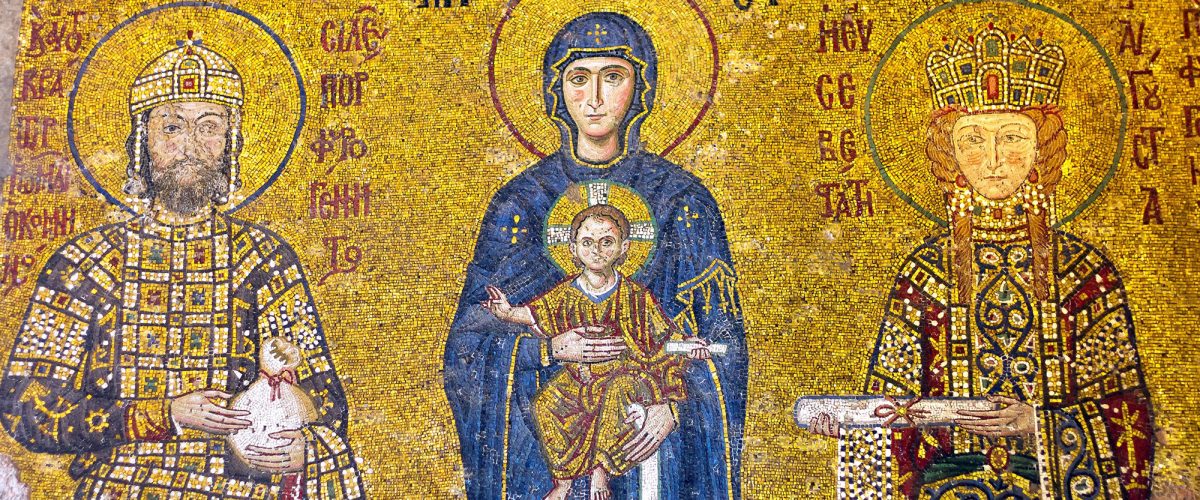This is the first in a four-part series BNG will publish every Monday during Advent.
There’s something about Mary, the mother of Jesus, that Baptists don’t quite know what to do with. I’ve noticed we tend to avoid Mary.
If your church follows the Lectionary, your congregation will not hear from Mary this Advent. In year A, the Lectionary Gospel texts are from Matthew — all from a male perspective. If your church does not follow the Lectionary, will you hear from Mary? Or at least hear about Mary? Will the gospel be preached by a woman like Mary sharing the good news of Jesus with us for the first time?
If the answer is no, where is Mary in our Baptist churches? Why have women, most of all, missed the voice of this heroine of the Gospels? Is Mary missing from our worship because she is female?

Julia Goldie Day
Or are we afraid of “Catholic” worship of Mary? We would have no reason to be accused of that, only hearing “Hail Mary” when watching a football game.
Is Mary missing from our worship of God during Advent and Christmas because we fear Mary, and her femininity, somehow supersede our devotion to God and our path to follow Jesus?
Is it that we don’t want to think too much about the female body — pregnancy, birth, breastfeeding and the act that brings children into this world?
While most Baptists believe Mary was a virgin when she gave birth to Jesus, we don’t believe, like some do, that Mary continued to maintain her virginal state. When we speak effortlessly of Jesus’ brothers, we accept that Mary did not remain a virgin in perpetuity. Mary would have engaged in sexual activity for those children to be born, for they were not God born in the same way as their brother Jesus.
I learned I was pregnant with our first child in November 2003. All December during Advent, I held that knowledge in my heart without telling anyone other than my spouse. That was a meaningful period of worship for me.
“What I was experiencing for the first time, Mary also experienced with Jesus.”
What I was experiencing for the first time, Mary also experienced with Jesus. No angel came to visit me to tell me the good news — a lowly pregnancy test and lots of vomiting told me I was to expect a child. Even so, it was magical, although I couldn’t explain why I was suddenly late for ministerial staff meetings having thrown up my breakfast and peed my pants, requiring a change of clothes to leave the house to go to the church I served.
I sensed the male senior pastor would just rather not know — so I didn’t explain myself, keeping my secret. My secret, my worship, was as Madeline L’Engle says of Mary and me, “she took him in — into the deepest part of her being … mother and child together in the greatest act of love the Maker could give the made.”
Mary was the first person to hear the gospel. She was the first person to share the gospel, in her song the Magnificat. The first person to know Jesus and know him intimately. We would be quite certain in believing Mary breastfed her baby, knowing there were few other options to feed a baby in those times.
Renaissance art that depicts Mary feeding Jesus is called Maria Lactans in Latin or the Nursing Madonna. Mary grew her child in her body, birthed him from her body in great pain and fed him from her body so he might live. She said, “This is my body given for you.” I don’t have to tell any mother that all those things come with great pain, sacrifice and with great love and wonder at what our bodies can do.
“Before the symbol of the Crucifixion became the major symbol of Christianity, the symbol of God’s love for humanity was just this — a mother nursing a child.”
Before the symbol of the Crucifixion became the major symbol of Christianity, the symbol of God’s love for humanity was just this — a mother nursing a child.
After the Renaissance paintings depicting Mary breastfeeding Jesus, the breast became sexualized. Unfortunately, my church got complaints when I nursed my first-born baby in a side room during worship with the door cracked as to still be a part of worship. Motherhood is encouraged, but don’t you dare nurse your baby anywhere near me!
So often we would prefer not to see or know what women do with their bodies.
We are uncomfortable with Mary because we are uncomfortable with women’s bodies. Mary may have been chastised because of her pregnancy during the engagement period. The text doesn’t support that she was harassed, but that could be easily imagined, as pregnancy out of wedlock was outside the sexual norm.

Madonna Litta, Leonardo da Vinci
We are uncomfortable with Mary because we don’t listen to women now — much less back then. It takes courage to listen to women because to do so upsets the status quo, which centers white male voices.
Mary isn’t white (despite how paintings depict her), she obviously isn’t male, and she has very few rights in her own culture — yet somehow God sees her as a person worthy of trust and blessing.
The gospel hinges on her acceptance of God’s blessing for her role as mother to Jesus. In fact, the beginning of Luke’s Gospel centers on the voice of Mary. She and Elizabeth are the ones with the message of God, prophets — all the while pregnant — while Zechariah, the religious leader, is literally silenced.
Listening to women is an underlying value in the gospel. Women are at the beginning and the end in prominent roles. They speak, and still we refuse to listen.
It seems like Mary may not have been believed either. She is “found to be pregnant” in the Gospel of Matthew. There we see from Joseph’s perspective that he needed to hear from an angel to believe the good news. The Nativity Story movie portrays this possibility beautifully. Joseph sees Mary is pregnant, is very disappointed and plans to divorce her quietly. But an angel in a dream convinces him that she is telling the truth — her child is a gift from the Holy Spirit.
We can imagine Mary spoke up to tell the story of her pregnancy, to explain the angel’s message to her, and she wasn’t believed. This fits with her characterization in the Gospel of Luke; Mary is bold and articulate in praising God and offering prophecy for God’s coming and already come kin’dom. She is co-creating with God with her body and her voice.
“For the Mighty One has done great things for me,
and holy is his name.” — Luke 1:49
Mary’s role as mother has implications that continue for us. We are to be reminded of her leadership in co-creating, nurture, protection and love that can remind us of Jesus comparing himself to a mother hen gathering her chicks under her wings in Luke 13:34. To accept the leadership of Mary, our mother, we are first called to listen and believe. Then we can be gathered and sheltered.
Listen to and believe women, a simple statement, yet applicable to those in the gospel story and our own lives. How will we believe the women and celebrate and honor the bodies of women in our own lives and in the life of our faith communities this Advent and Christmas? How will we reorient our eyes and ears to hear the gospel message of the greatest act of love from the mouths and lives of women?
A few practical suggestions to consider:
- Regularly invite a woman to preach during Advent or Christmas (and not just the Sunday after Christmas, which is “low attendance” Sunday). Or to go a step further, invite a woman to preach each Sunday in Advent, especially if you mostly hear a male voice from the pulpit. Resist the impulse to pat yourself on the back for “allowing women to preach,” which is quite different from empowering and partnering with women to lead us all.
- Give women a real chance in your search committees while searching for new ministerial staff, especially senior leadership. Note that many women are not allowed to serve in senior leadership positions and may have a varied background of employment (also due to raising children). Realize that looking for a woman with senior pastor leadership is looking for a woman who may not exist. Many women have been forced out of ministry positions and are at a disadvantage when engaging with search committees. Don’t be scared off by difficult stories when women are brave enough to share them. Remember the value of listening to and believing women.
- Do a women’s body audit of your church. Can women wear what they choose without comment? Can women bring their babies into the sanctuary? Can women breastfeed without being frowned upon? Are women’s bodies celebrated in all their many forms?
- Do a women’s voice audit of your church. How often are female voices heard? From the pulpit, in committee meetings, church reading/teaching materials, in Scripture readings? Utilize A Women’s Lectionary for The Whole Church, Year by Wilda C. Gafney at your church beginning in Advent 2023.
Julia Goldie Day is ordained through the Cooperative Baptist Fellowship and lives in Memphis, Tenn. She is a painter and proud mother to Jasper, Barak and Jillian. Learn more at her website.
Related articles:
The consent of mothers | Opinion by Julia Goldie Day
The sorrows of motherhood: Depictions of Mary’s sadness at the death of Christ | Analysis by Mallory Challis
An unlikely treasure of religious devotion found in a family attic | Opinion by Tom Allen


